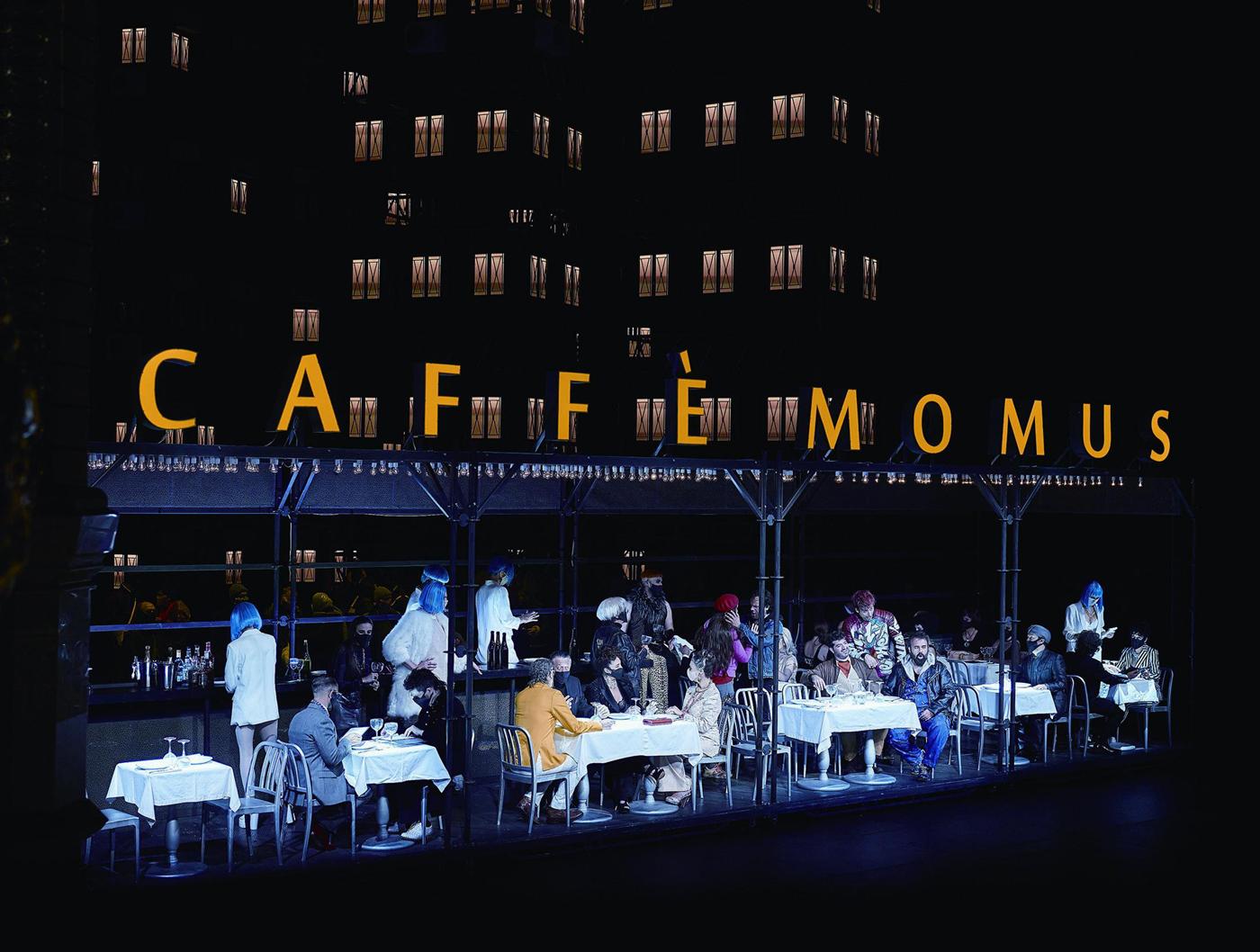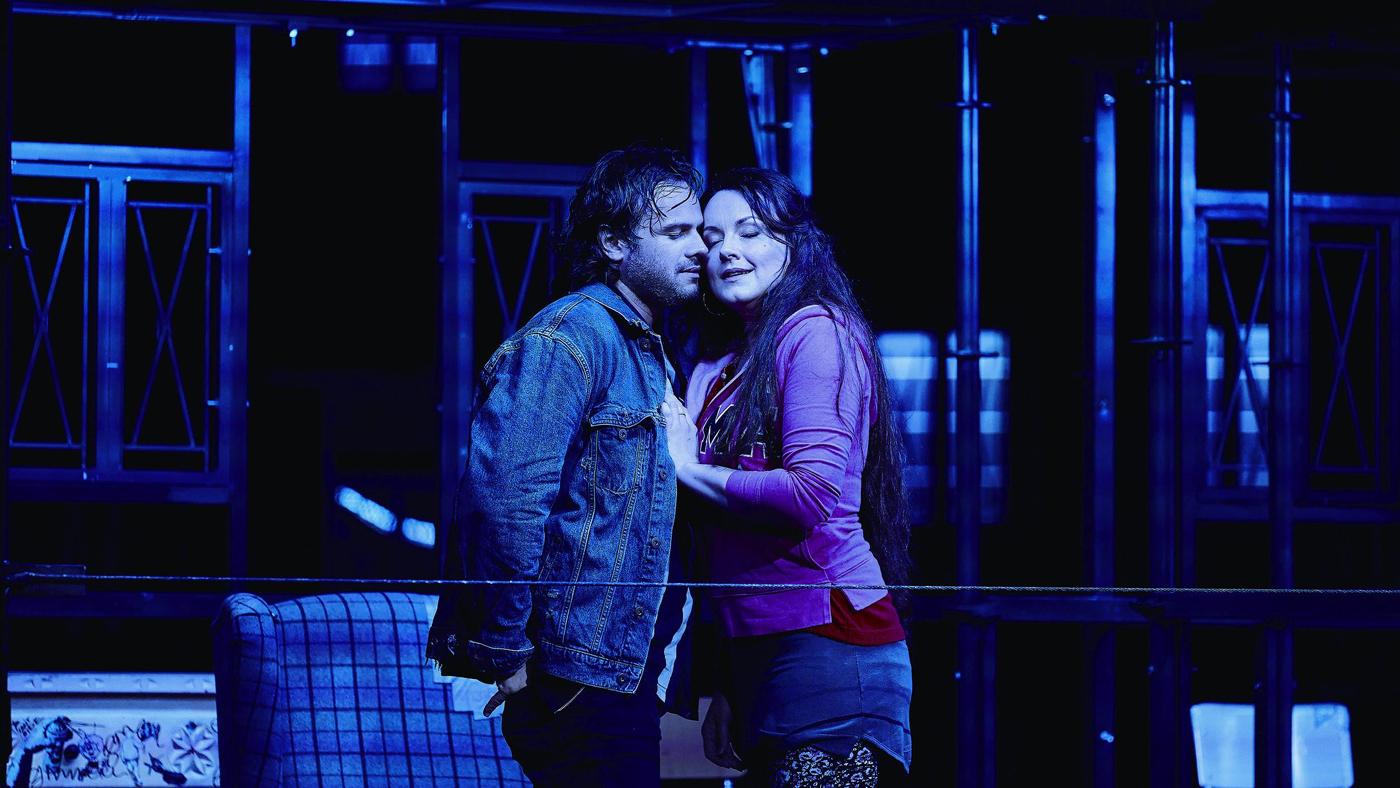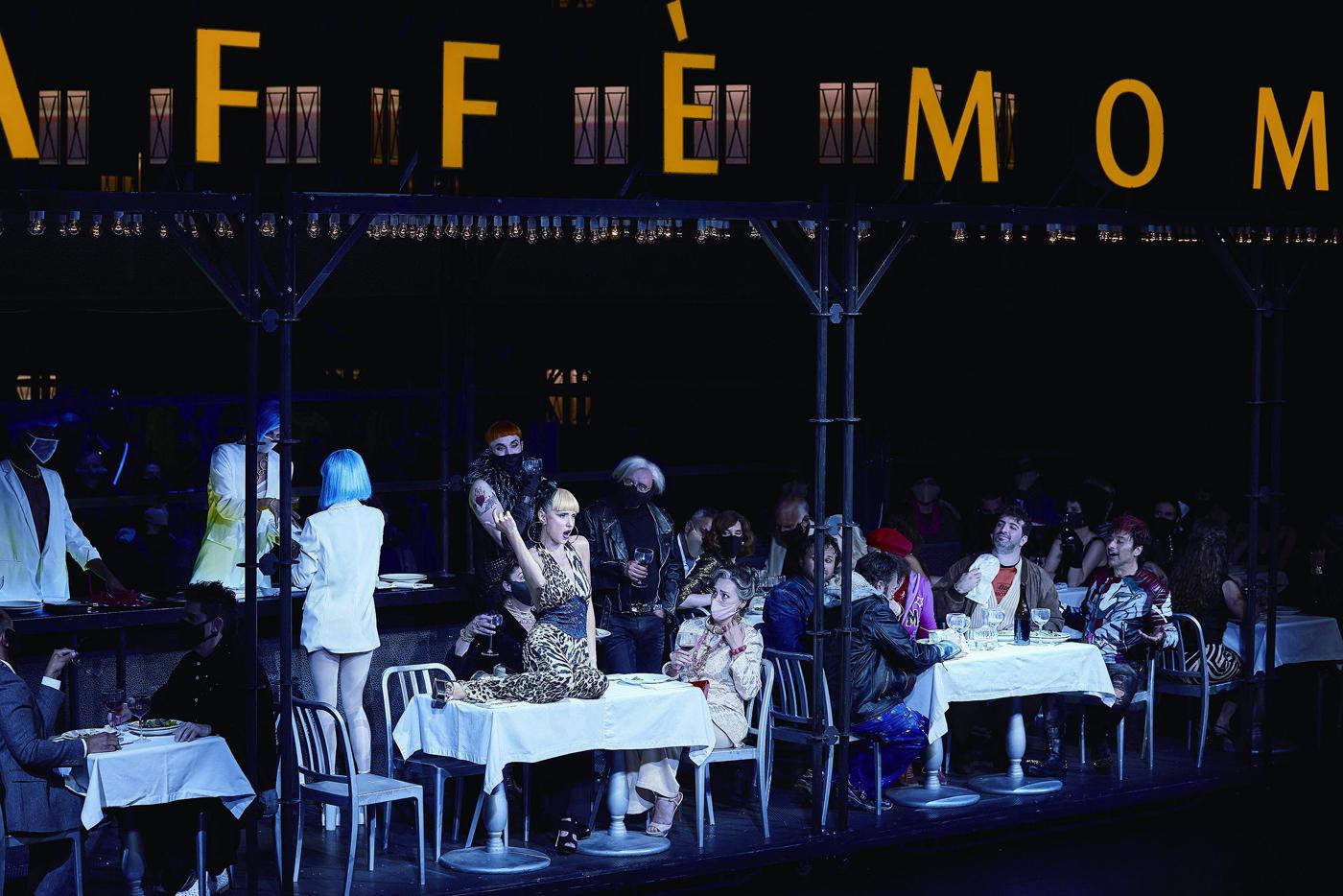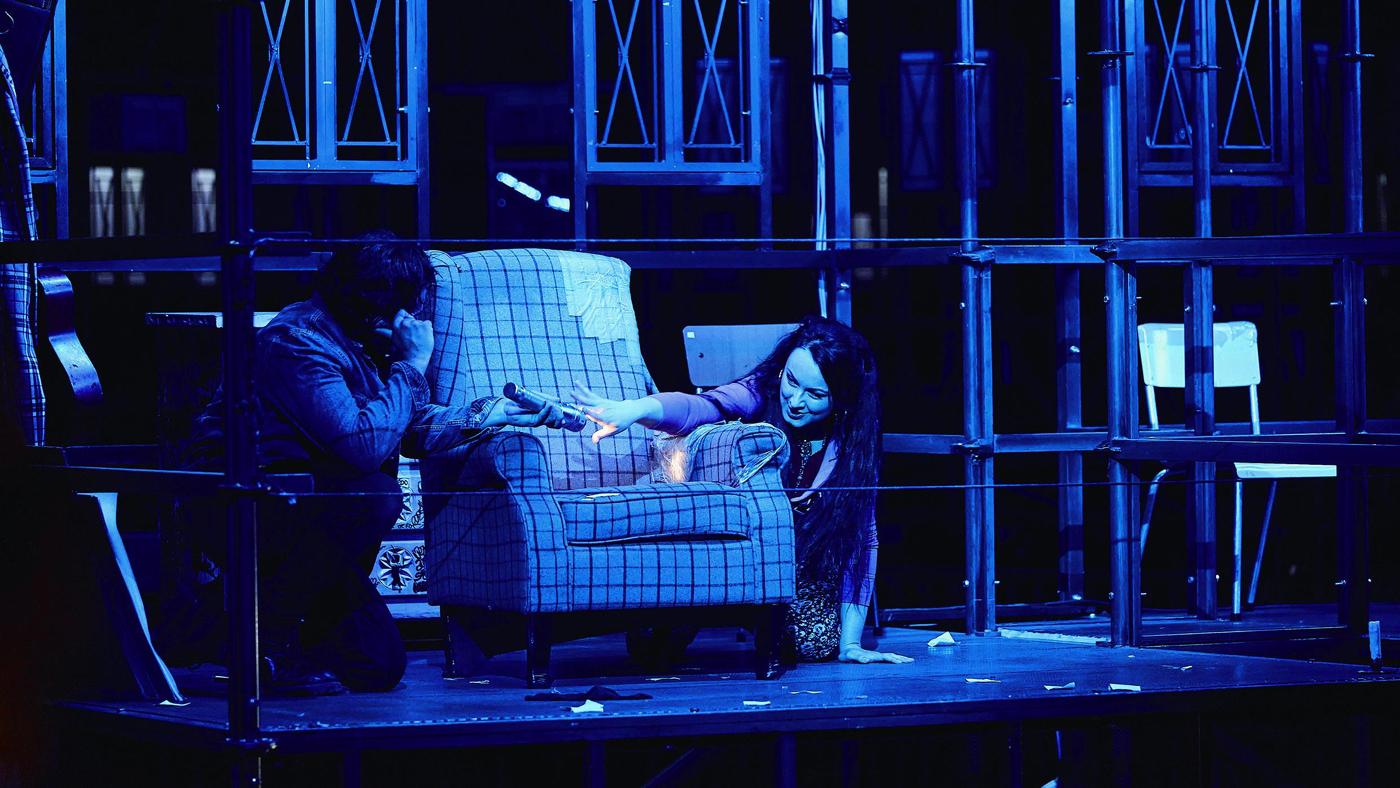《波希米亚人》归来!
司马勤
最近,有个问题令我伤透脑筋。导演亚历克斯·奥莱(Alex Ollé)在悉尼歌剧院把威尔第的《假面舞会》重构为一个犹如乔治·奥威尔(George Orwell)创作的反乌托邦式的噩梦而获得巨大成功。他更在东京新国立剧场把普契尼的《图兰朵》改头换面,注入卡夫卡式《城堡》的氛围,更添上埃舍尔(M.C. Escher)的视觉效果,令故事升华,讥诮权力斗争的意味更浓。为什么上月在巴塞罗那利索大歌剧院执导的《波希米亚人》却显得……怎么说呢,有点儿怀旧?
从表面上看,一切都显得那么现代:鲁道夫正在笔记本电脑上笔耕不辍,帮咪咪找钥匙的时候他手执者强光电筒(鹅毛笔与蜡烛都太19世纪了!)。剧中也有新冠疫情的影子:当合唱团出现时,几位“警察”走出来确保各人群保持了社交距离。奥莱是土生土长的巴塞罗那人,所以特别眷顾自己的家乡:普契尼笔下那些艺术家本应在巴黎左岸生活,却被空降至巴塞罗那的新城区波布雷诺(Poblenou,曾是工业区,现在却以“波希米亚”的时髦风格驰名);莫墨斯咖啡馆摇身一变,成为位于市中心加泰罗尼亚大道上的那种半露天式餐厅。
准确地说,这个制作的古雅风格大体源自导演选择的呈现手法。从叙事角度来看,奥莱摒弃了与原始叙事相类似的现代主义(或现代派);他更多地强调故事本身的具体元素,以构建出一种自然主义的叙事节奏。从大体的演出模式来看,制作恢复到了新冠疫情前的艺术标准:整部歌剧没有删减任何段落,中场休息如常进行。
为了直观地表现出巴塞罗那的演出模式有多么极端,让我们来对比一下近期我看到的两套《波希米亚人》吧。香港无限音乐剧场制作的歌剧电影以及哥伦布歌剧院搬演的舞台版本都是由茱莉亚·诺兰-美霞(Julia Noulin-Mérat)担纲制作人,两个制作都反映了新冠疫情对演艺界的影响——至少在美国,大部分的歌剧演出时长都不超过90分钟,本应参与演出的合唱团、本来设有的中场休息,甚至某些剧中人物都消失了。只有极少数的歌剧院还能够进驻它们平常演出的剧场。就算自己的演出驻地是可控的,剧院方还是尽量避免观众在场地里走来走去,以降低交叉感染传播病毒的概率。
把某些角色完全砍掉?几年前,如果某位导演提议把《波希米亚人》中的房东贝诺瓦(Benoit)删掉,肯定会引起巨大的争议,因为这个角色在歌剧里提供了喜剧性的插曲,让观众得以调剂心情。延续这种推想,不如把《卡门》中唐·何塞(Don José)留在农村的爱人米卡埃拉(Micaela)删掉——但香港无限音乐剧场刚刚推出的版本没有米卡埃拉;或者在《唐乔瓦尼》中减少几位被他引诱的美女?噢,我猜哥伦布歌剧院本年年初的版本已经实现了。
新冠疫情其实给导演与监制们提供了一个很好的借口,让他们重新审视核心歌剧剧目以及它们在今天社会大背景下的意义。数十年来,我们都把作曲家的总谱当作神圣的物件——有时候甚至把作曲家早已删掉的部分再次搬上舞台——大家都坚持作曲家谱写出来的音符是圣经般的存在而不是一个活生生的文档。当离开了传统的剧院与常规的舞台,我们才发现,不少音乐段落的用途,原来是为了让幕后人员有充分时间换景。当你把作品的架构从庞大的史诗缩小至短篇小说,会发现太多的情绪反差反而令观众分心,还阻碍了故事情节推前的动力。因此,无论是在电影版還是在哥伦布上演的《波希米亚人》里(两个演出版本所删减的段落都差不多),直至演出过后,我才意识到贝诺瓦从没有出现。更偏激的手法是把《卡门》里的卡门删掉、或让《托斯卡》中的托斯卡从头到尾都消失得无影无踪。试想,把《波希米亚人》的故事从贝诺瓦的角度叙述出来,干脆把剧目改为《贝诺瓦》(那就要请来新的作曲家了)得了。哎呀,我扯远了。
除了严格的“无房东”政策以外,无限音乐剧场与哥伦布歌剧院的《波希米亚人》都故意微调了观众的期望,加入了配合当今时势的元素(有什么能比女主角染上肺病更“浪漫”?)。这些小变动主要源于电影制作与沉浸式剧场本质上的区别。电影版《波希米亚人》浸润了纽约市这个活生生的都市环境,所以很多场戏都是外景拍摄。而哥伦布歌剧院的演出地点是艺术家工作室与画廊组成的小社区,为观众提供了更可信性的艺术氛围;这个偌大的空间也让大家可以保持社交距离。哥伦布歌剧院的演员们一直戴着口罩,除了提醒我们这出故事发生在今时今日之外,也保护了演员的健康。出演电影版的演员有时候戴上口罩,有时候摘掉口罩。导演这样的构思内有乾坤:故事发生的时间刚好回溯到新冠疫情初期,当时政府还没有颁布防疫令,还没有规定全体市民必须佩戴防疫口罩。(因为演员在拍摄期间只需要对口型而不是开嗓真唱,彼此之间保持距离就更具回旋余地。)
与此同时,几周后在巴塞罗那,奥莱让大家瞥见未来的一角——尽管我们活在当下,但不少过去的元素正在回归。他常用的舞美设计师阿尔方斯·弗洛勒斯(Alfons Flores)很清晰地分隔出公共与私人空间,反映了叙事中不同层面的情感。乌尔斯·施内鲍姆(Urs Sch?nebaum)负责的灯光设计在咪咪首次登场时特别突出(他故意把灯光调得若有似无)。但是利索大歌剧院是一个具有古典风格的剧院:我们聆听到的是普契尼的总谱,在这段特殊的时间里其他歌剧院删掉的合唱团、中场休息、“房东”全都在这个剧院得以重现……
我们也有机会得以欣赏到大乐队丰富的音乐。可惜,防疫规定却给乐队带来了编制与排位的问题。打击乐全都搬上了紧挨舞台旁边的包厢里。正因如此,节奏的精准度打了折扣,音量也难与其他声部找到平衡。演员也遭遇了同样的困难:鲁道夫与咪咪都是好演员,但他们的嗓音经常被乐队盖过。马切洛与穆塞塔的嗓子比较洪亮,尤其是穆塞塔演出时稍嫌刺耳。这令我回想起电影版与哥伦布版的《波希米亚人》(演员阵容有些重叠)。尽管他们在屏幕上、画廊里看起来、听起来都令人佩服,但他们之中有多少人可以在大歌剧院的舞台上真正压倒全场?
我很幸運,设法拿到了巴塞罗那本季《波希米亚人》最后一场演出的最后一张门票。正因如此,当晚看到台上或台下的现象可能加上了“天时地利”的滤镜。观众热烈的掌声主要是为整场演出而不是为了个别演员,仿佛是为了庆祝大伙儿可以重返歌剧院欣赏大家熟悉的演出模式而喝彩。演员们(合唱团没有机会在剧终后谢幕)除了鞠躬以外,更有拥抱、牵手、吻手等举动,什么社交距离和防疫礼仪都忘得一干二净。除了几分钟前舞台上所呈现的因呼吸系统疾病引致死亡的悲剧外,在谢幕那刻,观众们难掩兴奋之情,就如同新冠病毒从没有存在过,对于全球的影响也从未发生过那般。
Heres something thats been bothering me lately: If director Alex Ollé could turn Verdis Masked Ball into a dystopic Orwellian nightmare at the Sydney Opera House, and render Puccinis Turandot as a cynical power play in Kafkas Castle at the New National Theater in Tokyo, then why did his production of La Bohème last month at Barcelonas Gran Teatre del Liceu seem so…well, retro?
Everything looked so modern on the surface: Rodolfo was writing on a laptop, and went searching for Mimis key with a high-powered flashlight (quills and candles being so 19th century!). There were a couple of Covid touches, like the chorus coming on stage wearing masks while “policemen” ushered them into socially distant groups. Ollé (a Barcelona native himself) even played to the hometown crowd, airlifting Puccinis artists from Pariss left bank to a neighborhood that looked suspiciously like Barcelonas Poblenou district, with Café Momus morphing seamlessly into semi-enclosed dining on the Rambla de Catalunya.
Rather, the quaintness of the production had more to do with the means of presentation. From a storytelling aspect, Ollé forsook any modern (or modernistic) parallels with the original narrative and stuck mostly to concrete elements in the material in establishing a naturalistic pace. As for the general format, the evening marked a full return to pre-Covid norms, presenting the full opera uncut, complete with intermission.
To get an idea of how radical that seems now, lets compare this to the two other Bohèmes Ive seen recently. Both the film by More Than Musical and the stage production at Opera Columbus were produced by Julia Noulin-Mérat, but they reflect a general Covid ethos—at least in the United States—where operas now rarely last more than 90 minutes and do away with choruses, intermissions, and often entire characters. Few opera companies have access to their usual theatres, but even if they could control their own home space they certainly dont want audience members walking around infecting each other between acts. So no intermissions.
But entire characters? A couple of years ago, it would seem a heresy to cut the landlord Benoit from Bohème, since his character provides the operas only comic relief. You might as well stage Carmen without Micaela, Don Josés innocent love interest—no, wait, More Than Musical just did that in Hong Kong. Maybe a Don Giovanni without some of Giovannis conquests? Um, I think Opera Columbus did that earlier this year as well.
One thing the Covid era has provided was an excuse for directors and producers to explore the core of the repertory and what is truly essential. For many decades, weve worshipped the composers score—occasionally reinserting parts that the composer had actually removed—treating it a holy writ rather than a living document. Presented outside a traditional theatre space, it becomes obvious what music was there only to allow enough time for stagehands to change sets behind the curtain. Once you start shrinking a pieces structure from an epic to a novella, emotional contrasts become a distraction rather than a means to propel the story. Which is why, in the film and in Columbus (both employing nearly identical cuts in the score), I didnt really miss Benoit until the show was over. A more radical approach would be to cut Carmen from Carmen, or Tosca from Tosca. Or perhaps to recast Bohème from the point of view of the landlord in a production entitled Benoit(which would probably require a new composer). But I digress.
Beyond their strict “no-landlord” policy, both of those Bohèmes tweaked expectations in search of vernacular immediacy (what could be more relevant these days than a romantic lead with a lung disease?). The variances stemmed largely from inherent differences between cinematic presentation and immersive theatricality. The Bohème film embraced New York City as a living set, shooting much of the show in outdoor spaces. The Opera Columbus production was staged in an artist studio-gallery commune, providing a credible setting for the story while allowing distancing for the audience. The Columbus cast wore masks throughout, indicating a contemporary setting while protecting the actual cast members. The film cast was sometimes masked, sometimes not, consciously placing the setting as the early Covid period right before mask mandates became the norm. (Because they were lip-synching, not actually singing, the film cast had much more leeway.)
Meanwhile, a few weeks later in Barcelona, Olléprovided a glimpse of a future that, while living in the present, welcomed back many elements of the past. His regular set designer Alfons Flores conveyed clear breaks between public and private spaces, reflecting different emotional levels in the narrative. Urs Sch?nebaums lighting became particularly notable when Mimis entrance relied directly on it (or rather, the lack of it). But the Liceu is a classical performing space, which meant we also had Puccinis full score, along with all of the things that had recently fallen by the wayside: a chorus, an intermission, a landlord….
We also had a full orchestra, which was a bit problematic in its current pandemic spacing, placing the percussion in the proscenium boxes at stage level. This hampered both rhythmic precision and sonic balance in the hall. The cast, too, had problems in balance; although they acted well, Rodolfo and Mimi often had trouble cutting through the orchestra. Marcello and particularly Musetta fared better, though the extra volume also came with greater stridency in tone. This made me think about the casts in my two Bohèmes last month (there was some overlap). As impressive as they looked and sounded on the screen and in the gallery space, I wonder how many of them could actually sustain that presence in a regular opera house.
In Barcelona, I managed to get the last ticket available for the last performance of the run, which might account for the reaction on stage and in the house. The audience applauded primarily for the whole ensemble, rather than for individual singers, as if all the clapping was intended to mark the return to regular operagoing itself. As for the performers(the chorus didnt get a final bow), curtain calls came with many hugs, much holding and kissing of hands, and no social distance whatsoever. Except for the fact that a few moments earlier a character on stage had just died from a respiratory illness, there was little to remind the audience that we are all still emerging from a global pandemic.

